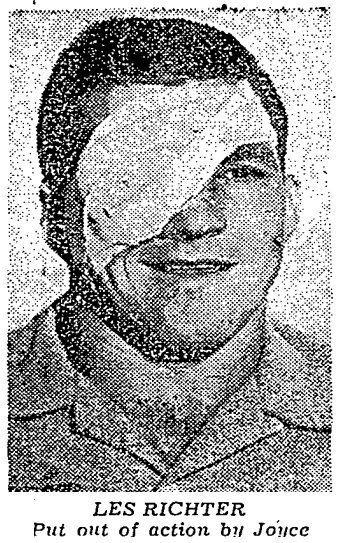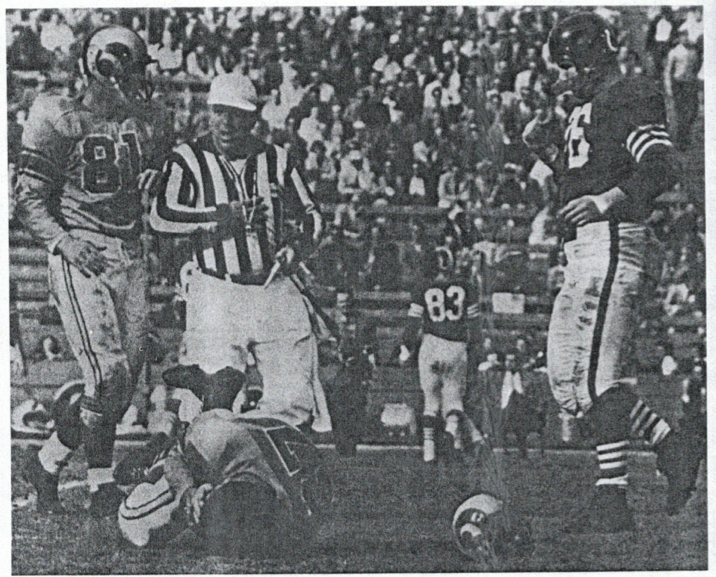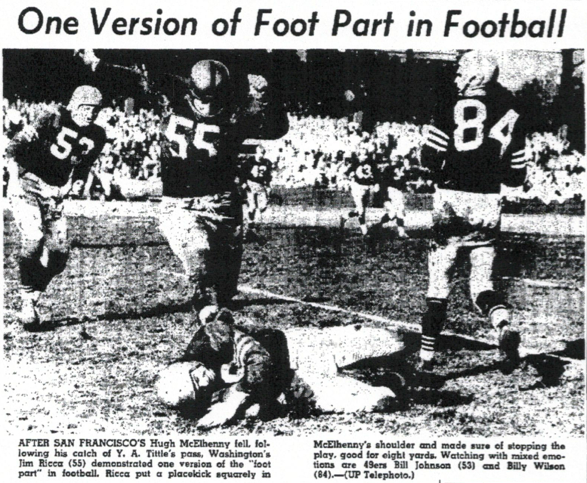There’ll never be another player like Hardy Brown, the linebacker-anesthesiologist for the 49ers in the ’50s. Compared to Hardy, Jack “They Call Me Assassin” Tatum sold Girl Scout cookies.
If you need further proof of the man’s menace, read this fabulous piece by Bob O’Donnell (taken from our 1990 book, The Pro Football Chronicle). To get you started, here’s a visual: Brown — aiming high, as always — about to reduce Browns quarterback Otto Graham to cracker crumbs.
“To me, Hardy Brown was the most unique player ever. Think of it this way: What Hardy Brown was all about in football wasn’t physical. Hardy was a psychic occurrence.”
— former Giants lineman Tex Coulter
Bob’s preface:
I saw my first Hardy Brown hit while watching films of the 1951 Browns-49ers game at the Pro Football Hall of Fame. A San Francisco defensive back intercepted a pass by Otto Graham and was weaving his way upfield when a sudden movement at the bottom of the screen caught my eye. It was like the flash a fisherman might see in a stream before his line grows taut. I reversed the film and watched again.
As a Browns receiver turned to pursue the play, he was struck so violently in the face that his helmet popped up on his head and his back hit the ground before his feet. Standing over him was Hardy Brown. You could almost hear him chuckling.
There isn’t much left of Hardy Brown. He’s been institutionalized in northern California with dementia, the result of years of hard drinking. He also has emphysema, and the arthritis in his right shoulder is so bad he can’t lift his arm to scratch his head.
Let’s start with The Shoulder. That’s where the legend begins. Hardy Brown played linebacker in the NFL at 6 feet, 190 pounds, and hit harder than any player before or since. His right shoulder was his weapon. He usually aimed it at an opponent’s head, and the results often were concussions and facial fractures – noses, cheeks, jaws . . . you name it, Brown broke it.
“It was early in the game,” former Eagles running back Toy Ledbetter recalls of his 1953 run-in with Brown, “and I was carrying on a sweep to the right. I knew about Brown because I’d been at Oklahoma State when he was at Tulsa. I usually kept my eye on him, but this time I cut inside a block and never saw him. He caught me with the shoulder and the next thing I knew I was on the ground looking for my head.”
The hit broke Ledbetter’s cheek. Dr. Tom Dow, Eagles team physician, said it was the worst facial fracture he’d seen. In Brown’s 10 pro seasons, spent in four different leagues, he laid low dozens in the same brutal fashion. Backs, ends, linemen, it didn’t matter. Brown was an indiscriminate maimer.
And what a mystery. No one could figure out how he hit with the force he did. In 1951, Bears coach George Halas had officials check Brown’s shoulder pads before a game. They found nothing. Nor could anyone figure Brown’s fury. He lived for the big hits. Relished them. They were his one marketable skill. Away from the game, he was reserved but friendly. On the field, he was a killer.
“I came out of the huddle at the beginning of the game and figured I’d say hello,” says ex-Giants lineman Tex Coulter, who grew up with Brown in a Fort Worth, Texas, orphanage. “I came up to the line and looked across at his linebacker spot, and his eyes looked like they belonged to some cave animal. They were fiery, unfocused. You don’t know if he could see anything or everything. I kept my mouth shut.”
Y.A. Tittle claims in his book, I Pass, that Brown knocked out 21 opponents as a 49er in ’51 – including, in the preseason, the Washington Redskins’ entire starting backfield. That might be an exaggeration; who kept an accurate count of such things? But Brown inspired exaggeration. Ex-players speak of him the way fight people speak of Sonny Liston.
“To me, Hardy Brown was the most unique player ever,” Coulter says. “Think of it this way: What Hardy Brown was all about in football wasn’t physical. Hardy was a psychic occurrence.”
Coulter knows Brown as well as anyone. They are about the same age and arrived at the Masonic Home orphanage at about the same time in 1929. Coulter is working on a book about their lives. To understand Hardy Brown, he says, you have to understand his past. That isn’t easy.
Hardy Brown’s father was murdered. Shot dead in a neighbor’s home in rural Kirkland, Texas, Nov. 7, 1928. Two men pumped four bullets into him. Hardy was in the room when it happened. He was four. Four months later, Brown was present again when a family friend murdered one of his father’s killers at point-blank range.
After the second incident, Brown’s mother sent her four youngest children to the Masonic Home in Fort Worth. Hardy was five. He claimed it was 12 years before he heard from his mother again, and then only to get her permission to enlist in the Marines.
The Masonic Home orphanage sits on over 200 acres of land southeast of downtown Fort Worth. It has its own dairy farm and school, with grades one through 12. In the ’30s, there was a matron for every 12 to 15 children. Discipline was rigid. Those who didn’t do their chores or got caught slipping off to Sycamore Creek after hours could expect to be cuffed.
Football was the great escape. It was rough, wild and (almost) without rules. Unless you were a sissy boy, you played. That was the last thing Hardy Brown was.
“Football gave us self-worth,” Coulter says. “We were orphans, but you couldn’t call us orphans. When the newspapers came out and wrote stories, they’d refer to us as ragtag kids, and that made us angry. That was pity from above, and we hated it. Football was a way to alleviate that.”
The Shoulder was born at the Masonic Home. It was the brainchild of Hardy’s older brother Jeff. Jeff reasoned correctly that human beings, like fence posts, were easier to knock down if you hit them high. So when an opponent approached, he’d crouch slightly and then spring into the player’s chin with his shoulder. In no time, everyone at the home was using “the humper,” as it came to be called.
“The city boys were frightened as hell of us,” Coulter says. “I don’t blame ’em, the way Hardy Brown was and I was, too, to some extent. The goddamn guys would be bleeding all over the place. You know, in high school ball, you just aren’t used to that. We speared, we leg-whipped, we used the humper, and I’m almost positive the man who invented the crackback block was our coach, Rusty Russell. We did all them things and didn’t think anything of it. We thought we were good, clean, rough boys.
Brown got out of the Masonic Home in 1941, enrolled at SMU and then went into the Marines, where he became the problem of the Japanese. He saw action in the Pacific as a paratrooper and, according to his sister Cathlyn, was on his way to Iwo Jima when a call came from West Point, of all places. It seems Army had pulled Coulter out of the enlisted ranks to play on its football team, and Coulter had put the coaches on to his Masonic Home teammate.
But Brown washed out of the Academy’s prep school after failing the math requirement (though a night of drunken revelry at a nearby girl’s school didn’t help). None too disappointed, he landed at Tulsa University in the fall of 1945. For the next three years, he terrorized the Missouri Valley Conference as a blocking back and linebacker.
New Orleans Saints president Jim Finks was Brown’s roommate at Tulsa and says he may have been at his destructive peak during those years.
“We’d put Brown at fullback if we wanted him to block one defensive end and put him at halfback if we wanted him to block the other,” Finks says. “There were many games when he literally knocked out both defensive ends. I think it was a game against Baylor that he put out the two ends on consecutive plays.
“He broke my nose and gave me four stitches at a goddamned practice!”
Brown got poor Toy Ledbetter in college, too. It came on a kickoff return, and Finks says it’s the hardest hit he’s ever seen. “Ledbetter lay there quivering,” he says. “Snot came out of his nose. He was bloody. He was down five minutes before they finally carried him off.”
Off the field, Brown occasionally got wild when he was drinking. He and his future wife, Betty, woke up Finks one night and shot up the dorm room with a .22 rifle. But for the most part, Finks says, Brown was “intelligent, warm and shy,” nothing like his on-field persona.
It took Brown a while to find permanent employment in pro ball. He broke in with the All-America Conference’s Brooklyn Dodgers in ’48 and went to the Chicago Rockets the next year. When the AAC folded, he wound up with the Washington Redskins, who waived him eight games into the ’50 season. Small, slow linebackers weren’t in demand.
But the word on Brown was getting around. He’d begun to leave a trail of bodies. Harry Buffington, head of the National scouting combine, was a guard for Brooklyn in ’48 and says one AAC team assigned a player to shadow Brown on the field and act as a “protector” for the other players. Tittle was with the Colts in ’50 and says running back Rip Collins told him before a game with Washington that he didn’t want to run pass routes in Brown’s area.
It was the Colts who signed Brown after the Redskins waived him, and in his first game with them he broke Giants running back Joe Scott’s nose with The Shoulder. The hit infuriated the Giants, and they tried to take their revenge.
Teams went after Brown as a matter of routine. He was a menace and could influence a game if he put a star player out. In a notorious incident in 1954, Lions defensive tackle Gil Mains jumped feet first into Brown on a kickoff return and opened a 20-stitch cut on his thigh. Brown was sewn up and returned to the game.
“I remember Hardy came up to me before a kickoff once and said, ‘How about an onsides kick?’” says CBS broadcaster Pat Summerall, a teammate of Brown’s in ’56. “It was a close game with the Giants, and I told him I couldn’t do that on my own without hearing from the coaches. He said he thought it would be a good idea. . . . Anyway, I kicked off as far as I could kick it, and here comes the whole Giant team after Hardy. They never even looked at the ball.”
The Colts went belly up after the 1950 season, and Brown found a home in San Francisco. He was the 49ers’ starting left linebacker for five seasons. It’s difficult even to estimate how many players he KO’d with The Shoulder. One a game? That’s probably too many. But you just don’t know, because newspapers didn’t devote much space to defensive play.
Game stories on a 49ers-Cardinals exhibition in ’51, for instance, state that as many as six Chicago players were put out of the game, three with broken noses. The San Francisco Chronicle added the line: “Against the Cards, Hardy Brown . . . played as vicious a line backing game as the 49ers ever had.” How many of those broken noses were Hardy’s doing is anyone’s guess.
Brown may have been most dangerous on special teams, where it was easier to freelance and there was a field full of targets. Lions linebacker Carl Brettschneider said one of Brown’s favorite tactics on punts was to line up behind an official so the opposing center couldn’t see him, then catch him with The Shoulder as soon as he raised his head after the snap.
“He broke more jaws than any guy going,” Brettschneider said.
Brown loved to talk about those bone-rattling blows. He apparently didn’t lose any sleep over the injuries he caused, either. He also missed a lot of tackles because he aimed for the head.
“I don’t think he ever went out to hurt anyone,” Coulter says. “I think Hardy was shaped a certain way. One thing about a hard hitter is that you don’t realize what it feels like to be hit. When you’re doing the hitting, when you stick someone with that shoulder, it’s a beautiful feeling. By God, it gives you a sense of power that reaches right to the back of your head. I think Hardy enjoyed that feeling.”
Age and size caught up to Brown in ’56. The 49ers waived him in training camp. He played briefly with Hamilton in the CFL and then signed with the Cardinals. At the end of the ’56 season, the Cards released him.
In 1960, Toy Ledbetter had stopped by the locker room of the newly formed Denver Broncos to visit two former Eagles teammates when he heard a high-pitched cackle behind him. Ledbetter turned to see, of all people, his old nemesis Hardy Brown sitting in front of a locker.
“How’s the cheekbone, Toy Boy?” Brown said.
Ledbetter laughed and shook hands with Brown. “No hard feelings,” Ledbetter told him.
“You asshole.”
After being released by the Broncos, Brown fell on hard times. He and his wife, Betty, broke up for a while. He held a number of construction jobs in the Southwest. And he continued to drink heavily. In 1986 he had to be institutionalized.
Family members say Brown never lost his desire to play football. At some point after he retired, he became involved with a semipro team.
The story is some young punk was giving him lip one day, and Brown decked him. Put him in the hospital.
 (In an era in which few holds were barred, Joyce was one of the tougher customers. As Carl Brettschneider, a roughhousing linebacker for the Cardinals and Lions, put it: “Every team had a guy the other team was always aware of – guys like Hardy Brown, John Henry Johnson, Bucko Kilroy, Don Joyce. You didn’t turn your back on Don Joyce.”)
(In an era in which few holds were barred, Joyce was one of the tougher customers. As Carl Brettschneider, a roughhousing linebacker for the Cardinals and Lions, put it: “Every team had a guy the other team was always aware of – guys like Hardy Brown, John Henry Johnson, Bucko Kilroy, Don Joyce. You didn’t turn your back on Don Joyce.”)


